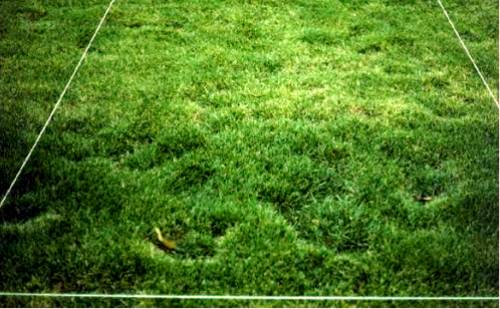-
Damage
The location of this disease is home lawns and golf courses. General symptoms are a patch, or irregular coloring. Foliar symptoms are browning and yellowing. This can occur during the months of April, May, June, July, August, September, and October. Hosts of the disease are Kentucky Bluegrass, Fine Fescue, Annual Bluegrass, and Rough Bluegrass.
Management
Summer symptoms are the result of the inability of the turfgrass to take up adequate amounts of water during the summer stress period because the fungus has destroyed the root system during the cool weather. One way to keep the weakened plants alive during the summer is through the use of light, daily irrigation. Turf should be irrigated daily with between 0.1 and 0.2 in. (0.25 and 0.5 cm) of water, preferably applied between noon and 4:00 P.M. This rate can be doubled during periods of prolonged droughts.
Adequate levels of nitrogen should also should be used in the management of necrotic ring spot. Improved Kentucky bluegrass cultivars require 4-6 lb (2 to 2.9 kg) of actual nitrogen per 1000 ft2 (100 m2) per season. Slow release nitrogen fertilizers such as Turf Restore, Nature Safe, Lawn Restore, IBDU, UF etc, are more effective in managing the disease than fast-release fertilizers like urea. Complete fertilizers (N-P-K) with slow release nitrogen carriers are the most effective.
Curative: The thiophanate methyl and azoxystrobin fungicides provide the best curative management. To be effective, these fungicides need to be drenched into the soil before they dry on the foliage, so that they are translocated upward from the roots. Best results are obtained when the turf is irrigated before the fungicides are applied.
Preventive: The DMI fungicides such as fenarimol, myclobutanil, and propiconazole work best preventively. These fungicides are translocated in both directions, and do not have to be drenched into the soil to be effective. Unless adequate nitrogen is applied, these fungicides will not be effective.








 Print
Print Email
Email